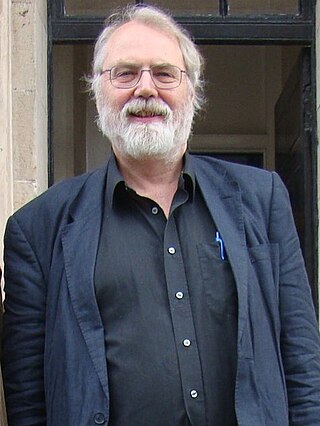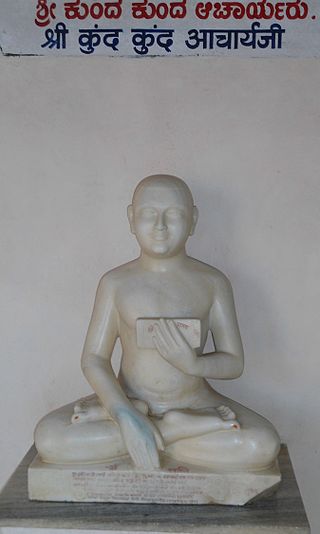Jainism, also known as Jain Dharma, is an Indian religion. Jainism traces its spiritual ideas and history through the succession of twenty-four tirthankaras, with the first in the current time cycle being Rishabhadeva, whom the tradition holds to have lived millions of years ago, the twenty-third tirthankara Parshvanatha, whom historians date to the 9th century BCE, and the twenty-fourth tirthankara Mahavira, around 600 BCE. Jainism is considered to be an eternal dharma with the tirthankaras guiding every time cycle of the cosmology. The three main pillars of Jainism are ahiṃsā (non-violence), anekāntavāda (non-absolutism), and aparigraha (asceticism).

Saṃsāra is a Pali/Sanskrit word that means "wandering" as well as "world," wherein the term connotes "cyclic change" or, less formally, "running around in circles." The "cyclicity of all life, matter, and existence" is a fundamental belief of most Indian religions. When related to the theory of karma it is the cycle of death and rebirth, also referred to with terms or phrases such as transmigration/reincarnation, karmic cycle, or Punarjanman, and "cycle of aimless drifting, wandering or mundane existence".

Mahavira, also known as Vardhamana, was the 24th tirthankara of Jainism. He was the spiritual successor of the 23rd tirthankara Parshvanatha. Mahavira was born in the early part of the 6th century BCE into a royal Kshatriya Jain family in ancient India. His mother's name was Trishala and his father's name was Siddhartha. They were lay devotees of Parshvanatha. Mahavira abandoned all worldly possessions at the age of about 30 and left home in pursuit of spiritual awakening, becoming an ascetic. Mahavira practiced intense meditation and severe austerities for twelve and a half years, after which he attained Kevala Jnana (omniscience). He preached for 30 years and attained Moksha (liberation) in the 6th century BCE, although the year varies by sect.

The Śvētāmbara is one of the two main branches of Jainism, the other being the Digambara. Śvētāmbara means "white-clad", and refers to its ascetics' practice of wearing white clothes, which sets it apart from the Digambara "sky-clad" Jains, whose ascetic practitioners go nude. Śvētāmbaras do not believe that ascetics must practice nudity.

Bimbisāra or Shrenika and Seniya in the Jain histories was the King of Magadha and belonged to the Haryanka dynasty. He was the son of Bhattiya. His expansion of the kingdom, especially his annexation of the kingdom of Anga to the east, is considered to have laid the foundations for the later expansion of the Mauryan Empire.

Parshvanatha, also Pārśvanātha, Parshva, Pārśva and Parasnath, was the 23rd of 24 Tirthankaras of Jainism. He is the only Tirthankara who gained the title of Kalīkālkalpataru.

Buddhism and Jainism are two Indian religions that developed in Magadha (Bihar) and continue to thrive in the modern age. Gautama Buddha and Mahavira are generally accepted as contemporaries. Jainism and Buddhism share many features, terminology and ethical principles, but emphasize them differently. Both are śramaṇa ascetic traditions that believe it is possible to attain liberation from the cycle of rebirths and deaths (samsara) through spiritual and ethical disciplines. They differ in some core doctrines such as those on asceticism, Middle Way versus Anekantavada, and self versus not-self.

Ācārya Bhadrabāhu was, according to the Digambara sect of Jainism, the last Shruta Kevalin in Jainism. He was the last acharya of the undivided Jain sangha. He was the spiritual teacher of Chandragupta Maurya, the founder of the Maurya Empire.
In Jainism, Pudgala is one of the six Dravyas, or aspects of reality that fabricate the world we live in. The six dravyas include the jiva and the fivefold divisions of ajiva (non-living) category: dharma (motion), adharma (rest), akasha (space), pudgala (matter) and kala (time). Pudgala, like other dravyas except kala is called astikaya in the sense that it occupies space.
Anekāntavāda is the Jain doctrine about metaphysical truths that emerged in ancient India. It states that the ultimate truth and reality is complex and has multiple aspects.
Jainism is a religion founded in ancient India. Jains trace their history through twenty-four tirthankara and revere Shree Rishabhnatha Bhagwan as the first tirthankara. The last two tirthankara, the 23rd tirthankara Parshvanatha and the 24th tirthankara Mahavira are considered historical figures. According to Jain texts, the 22nd Tirthankara Neminatha lived about 5,000 years ago and was the cousin of Sri Krishna Bhagwaan.
Kevala gyana or Keval gyan also known as Kaivalya means omniscience in Jainism and is roughly translated as complete understanding or supreme wisdom.
Mulachara is a Jain text composed by Acharya Vattakera of the Digambara tradition, around 150 CE. Mulachara discusses anagara-dharma – the conduct of a Digambara monk. It consists twelve chapters and 1,243 verses on. It is also called Digambara Acharanga.

Sukhlal Sanghvi, also known as Pandit Sukhlalji, was a Jain scholar and philosopher. He belonged to the Sthanakvasi sect of Jainism. Pandit Sukhlal lost his eyesight at the age of sixteen on account of smallpox. However, he persisted and became profoundly versed in Jain logic and rose to become a professor at Banaras Hindu University. Paul Dundas calls him one of the most incisive modern interpreters of Jain philosophy. Dundas notes that Sanghavi represents what now seems to be a virtually lost scholarly and intellectual world. He was a mentor for famous Jain scholar Padmanabh Jaini. During his lifetime he won such awards as the Sahitya Akademi Award and won recognition from the Government of India by getting Padma Bhushan award. Sukhlalji was also known as Pragnachaksu because he was so vastly learned despite being visually disabled.
Jīva or Ātman is a philosophical term used within Jainism to identify the soul. As per Jain cosmology, jīva or soul is the principle of sentience and is one of the tattvas or one of the fundamental substances forming part of the universe. The Jain metaphysics, states Jagmanderlal Jaini, divides the universe into two independent, everlasting, co-existing and uncreated categories called the jiva (soul) and the ajiva. This basic premise of Jainism makes it a dualistic philosophy. The jiva, according to Jainism, is an essential part of how the process of karma, rebirth and the process of liberation from rebirth works.

Paul Dundas was a British Indologist, an honorary fellow in Sanskrit language and Head of Asian studies at the University of Edinburgh. His teachings and research focused extensively on understanding Jainism, Buddhism, Sanskrit literature and Middle Indo-Aryan philology. He was regarded as one of the leading scholars in Jaina and Prakrit studies. He was a member of the Council of the Pali Text Society.

Umaswati, also spelled as Umasvati and known as Umaswami, was an Indian scholar, possibly between 2nd-century and 5th-century CE, known for his foundational writings on Jainism. He authored the Jain text Tattvartha Sutra. Umaswati's work was the first Sanskrit language text on Jain philosophy, and is the earliest extant comprehensive Jain philosophy text accepted as authoritative by all four Jain traditions. His text has the same importance in Jainism as Vedanta Sutras and Yogasutras have in Hinduism.
According to the Jain cosmology, the śalākapuruṣa "illustrious or worthy persons" are 63 illustrious beings who appear during each half-time cycle. They are also known as the triṣaṣṭiśalākāpuruṣa. The Jain universal or legendary history is a compilation of the deeds of these illustrious persons. Their life stories are said to be most inspiring.

Digambara is one of the two major schools of Jainism, the other being Śvētāmbara (white-clad). The Sanskrit word Digambara means "sky-clad", referring to their traditional monastic practice of neither possessing nor wearing any clothes.

Jainism is an Indian religion which is traditionally believed to be propagated by twenty-four spiritual teachers known as tirthankara. Broadly, Jainism is divided into two major schools of thought, Digambara and Svetambara. These are further divided into different sub-sects and traditions. While there are differences in practices, the core philosophy and main principles of each sect is the same.













